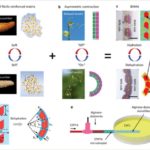Bioinspired Soft Microactuators
Soft actuators have the potential of revolutionizing the field of robotics. However, it has been a long-standing challenge to achieve simultaneously: i) miniaturization of soft actuators, ii) high contrast between materials properties at their “on” and “off” states, iii) significant actuation for high-payload mechanical work, and iv) ability to perform diverse shape transformations. This challenge is addressed by synergistically utilizing structural concepts found in the dermis of sea cucumbers and the tendrils of climbing plants, together with microfluidic fabrication to create diatomite-laden hygroscopically responsive fibers with a discontinuous ribbon of stiff, asymmetrically shaped, and hygroscopically inactive microparticles embedded inside. The microactuators can undergo various deformations and have very high property contrast ratios (20–850 for various mechanical characteristics of interest) between hydrated and dehydrated states. The resulting energy density, actuation strain, and actuation stress are shown to exceed those of natural muscle by ≈4, >2, and >30 times, respectively, and their weight-lifting ratio is 2–3 orders of magnitude higher than the value of recent hygroscopic actuators. This work offers a new and general way to design and fabricate next-generation soft microactuators, and thus advances the field of soft robotics by tailoring the structure and properties of deformable elements to suit a desired application.
Learn about our two Decals!
 Click here to find out more about our Fall Bioinspired Design Decal and our Spring Bioinspired Design in Action Decal – ALL MAJORS are welcome.
Click here to find out more about our Fall Bioinspired Design Decal and our Spring Bioinspired Design in Action Decal – ALL MAJORS are welcome.Berkeley BioDesign Community
 Click here to learn about the BioD: Bio-Inspired Design @ Berkeley student organization or here to signup for more info.
Click here to learn about the BioD: Bio-Inspired Design @ Berkeley student organization or here to signup for more info.Search
Student Login




I imagine that the neurological circuits underlying these processes are governed by both 2d spacing maps with their brains as…
to reduce the impact of car accidents, it may be possible to study the force diverting physics of cockroaches to…
you see this type of head-bobbing stability in many avian creatures related to pigeons like chickens. the head ability to…
not like they taught horses how to run! this is an example of convergent evolution where both sea creatures and…
The brain functions in a similar way with neuronal connections. our brains are able to utilize the multiplicity of connections…